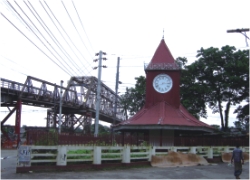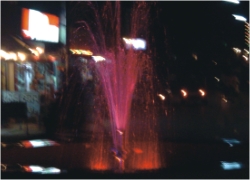 |
|
 |
|
 |
|
 |
|
Sylhet growing as a modern urban centre
Iqbal Siddiquee
Historic ‘Ali Amzader Ghodi’ on the bank of the river Surma in Sylhet city The small township, starting in 1869 through the Act VII (District Town Act) of the then British government Sylhet has grown into a metropolitan city. The country's youngest divisional headquarters located in its north east- Sylhet is one of the oldest towns and the fourth most populous urban centre. It stands on the northern bank of the river Surma. Under the said Act, the then small town of Sylhet had the Surma river on the south, hills and a tea garden of Mr. Hudson on the north, Dewanbag and Old Railline Road on east and Akhalia and Chundrai's Church on the West as its boundary. The district magistrate was made chairman of the 16 men town committee.
The Sylhet Municipality was established in 1878 under the provisions of Act V of 1876. After nearly 125 years, in 2002, the Sylhet municipality was upgraded into City Corporation, years after formation of the Sylhet division.
By now, with an area of 50 square miles the city is known as the city of great Muslim saint Hazrat Shahjalal (R). The city also known as the spiritual capital of the country is losing its past glories of a rich heritage coupled with the fame of the land of oranges and indigenous cane industry. A number of great personalities like Rabindranath Tagore, Poet Nazrul, Mahatma Gandhi, Moulana Mohammad Ali, Moulana Shaokat Ali, Hossain Shahid Suhrawardy, Sher-e-Bangla AK Fazlul Haque and Manik Bandopadhyay visited Sylhet on different occasions.
Another historic event needs to be quoted. Syed Mohammad Hadi and Syed Mohammad Mahdi -- the two brothers embraced martyrdom in a direct fight with the British Collector Robert Lindsey in 1782 (even before the mutiny of 1857). Lindsay made his fortune in Sylhet as he had served here for about 12 years.
The city has been growing haphazardly in the east-west direction, while its population is about six lakh.
Although it is far behind the city dwellers' expectation, a slow development of the city has been taking place. The city is fast losing its old age scenic beauty of greenery on the hillocks with the process of urbanisation. But, organised efforts are still absent to attract more tourists from home and abroad, although there are a good number of places of interest in Sylhet. However, some private initiatives are coming up in the form of scattered ventures in the tourism sector. Every day, thousands of people do visit the city for enjoying the natural beauties at Jafflong, Madhabkuunda and other places in the district. The other places include, Osmani Jadughar, Gourgovinda's Tila, historic Shahi Eidgah, Gopal Tila, Kendrio Muslim Sahitya Parishad Library, Shahjalal University etc.
The people of Sylhet living in the UK, US and other countries do play a significant role in the Sylhet society as a whole. But they normally get interested in investing for construction of shopping malls and houses finding no other option.
Organised ventures are absent as yet to create better scopes for them. The amount of idle money, lying with the commercial banks here as deposits is about 4,000 crore taka, which is very uncommon in other parts of the country. The bankers find no suitable scope for investment here.
But,new matters of concern are awaiting the people here. The geologists and other scientists say the Sylhet region falls within the most earthquake prone zone of the country. During the last 150 years three major earthquakes (surface-wave magnitude larger than 7.5 on the Richter Scale ) have occurred in this area. But local people are not that aware of the seismic status of the region. Since the last catastrophic earthquake occurred in 1918, very few people remember it.
The experts clearly say a strong earthquake affecting a major urban centre like Sylhet may result in damage and destruction of massive proportions and may have very long term consequences for the entire country. Like most major urban centres in our country, Sylhet has grown tremendously in the last few decades due to unabated migration from the smaller towns and rural areas. As a result, the city has developed in an unplanned way with little consideration for proper town planning norms. Moreover, about 80 per cent of the buildings were constructed without following the building code.
....................................................
The author is Sylhet Correspondent of The Daily Star.

